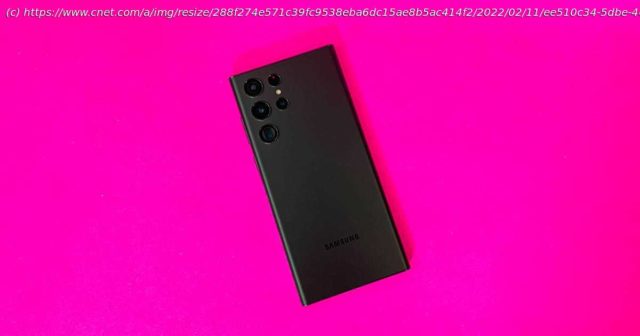The Galaxy S22 Ultra is one of Samsung’s most expensive phones, and for good reason. It comes with a top-notch camera system , a …
The Galaxy S22 Ultra is one of Samsung’s most expensive phones, and for good reason. It comes with a top-notch camera system, a gigantic screen and a stylus you can store inside the phone. But its hefty price can also make it a tough sell. That’s why it’s important to think carefully about whether it’s time to upgrade to the Galaxy S22 Ultra. In many cases, the most important factors to consider will be camera quality and the S Pen. If you have a relatively recent phone like the Galaxy S21 Ultra or Note 20 Ultra, you don’t need to upgrade just yet. The S22 Ultra is more of an iterative update to those devices, and you’ll get more for your money by holding onto your device for a longer period of time. Read more: Galaxy S22 vs.5 Older Samsung Phones: Is Upgrading Worth It? You’re much more likely to notice the Galaxy S22 Ultra’s new features when coming from a phone that’s at least 3 years old. That said, it’s also worth noting that the older your phone is, the less likely it is to continue getting the latest software updates. Samsung is guaranteeing four generations of Android operating system updates on phones in its families of Galaxy S22, S21 and Z devices, as well as certain Galaxy A phones. It previously committed to three years of updates, meaning some older phones like the Galaxy S10 and Note 10 might be close to the end of their software update cycle. You’ll also want to consider some of the features present on older phones that Samsung has eliminated on newer models. Samsung’s new phones don’t have expandable storage, for example, but the Galaxy Note 20 Ultra, S20 Ultra and Note 10 Plus do. Samsung also phased out MST support for Samsung Pay, the technology that enables the payment service to work with older terminals that don’t support NFC, starting with the Galaxy S21 line in the US. (MST is still available in select global markets.) Read on to learn more about how the Galaxy S22 Ultra compares with Samsung’s older high-end phones. If you have a Galaxy S21 Ultra, there’s no need to upgrade yet. The Galaxy S22 Ultra is an iterative update to its predecessor. It comes with a newer processor ( Qualcomm Snapdragon 8 Gen 1 or Samsung’s latest Exynos chip depending on the market), a camera that can perform better in low light and an S Pen that you can store inside the device. But those reasons alone aren’t enough to spend on a new device, especially since you can purchase an S Pen for the Galaxy S21 Ultra separately. The Galaxy S22 Ultra’s improved low-light photography is useful, but its camera system is otherwise very similar to the Galaxy S21 Ultra’s. Both devices have a 108-megapixel main sensor, a 12-megapixel ultrawide camera and two 10-megapixel telephoto lenses that provide a 10x optical zoom. Their screens are equal in size and both support refresh rates of up to 120Hz for smoother scrolling. That’s a detailed way to say the overall experience is essentially the same on the S21 Ultra and S22 Ultra, with some iterative upgrades to the camera and included S Pen. The bottom line: There’s no major reason to upgrade to the S22 Ultra if you have the Galaxy S21 Ultra. The updates are mostly iterative and will be more noticeable when upgrading from an older phone. If you’re a Galaxy Note fan looking to store your S Pen inside the Galaxy S21 Ultra, you’re better off buying a case that includes a storage slot for the stylus. The Galaxy Note 20 Ultra is less than 2 years old, which means it should have plenty of mileage left in it. There isn’t much to be gained from the S22 Ultra other than its camera improvements, which are appreciated but likely aren’t enough to justify upgrading for most people. Both phones have a 108-megapixel main camera and a 12-megapixel ultrawide camera, although the S22 Ultra has a newer version of the main sensor with better autofocus and dynamic range. Where they really differ, however, is in their zoom capabilities. The Galaxy S22 Ultra has two 10-megapixel telephoto lenses, while the Note 20 Ultra only has one 12-megapixel telephoto lens. As a result, the Galaxy S22 Ultra can achieve a closer zoom both optically and digitally (10x optical zoom and up to 100x digital zoom), compared with the Galaxy Note 20 Ultra (5x optical zoom, up to 50x digital zoom). And of course, the Galaxy Note 20 Ultra is missing Samsung’s recent improvements to low-light photography that debuted with the Galaxy S22 series. The S22 Ultra also takes better portraits than the Note 20 Ultra since it’s better at distinguishing fine details, my colleague Lexy Savvides wrote in her recent comparison of the two phones. The Galaxy S22 Ultra also has a sharper 40-megapixel front camera than the Galaxy Note 20 Ultra’s 10-megapixel selfie camera. That might not matter to everyone, but it could be an important consideration if you spent a lot of time on video calls. The Galaxy S22 Ultra also comes with a newer processor and a larger battery, although the difference doesn’t seem to be game-changing. Both phones are capable of lasting an entire day, according to CNET’s S22 Ultra and Note 20 Ultra comparison. The Galaxy S22 Ultra would typically have 20% of its battery left by the end of the day, while the Note 20 Ultra would have 10% to 15% of its battery remaining. Our test applies to the Qualcomm Snapdragon-powered version of these phones, so it’s possible that the Exynos versions could differ. And both phones come with Samsung’s S Pen stylus for taking notes, drawing and marking up documents.






